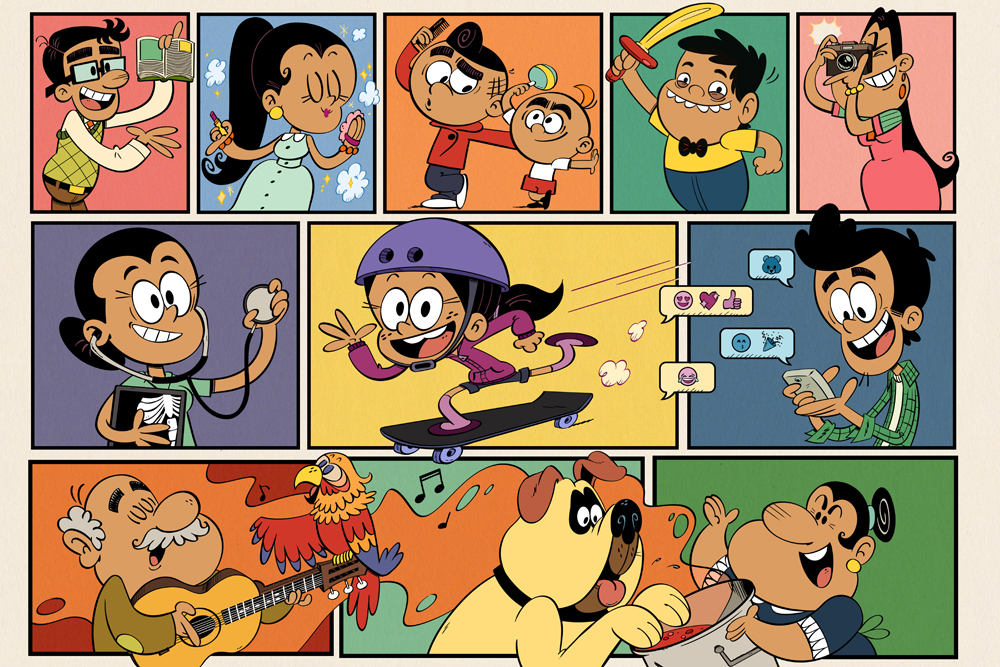***This story originally appeared in the November ‘19 issue of Animation Magazine (No. 294)***
Bursting onto television screens this fall, The Casagrandes follows a large, loving family living together in the big city. A companion to the Emmy Award-winning The Loud House, the new 2D-animated series highlights the culture, humor and love of growing up in a multi-generational Mexican-American family, and is set to debut October 14 on Nickelodeon.
The Loud House, which debuted in May 2016 and is centered around 11-year-old Lincoln Loud and his 10 sisters, gives an inside look at what it takes to survive the chaos of a huge family. The Casagrandes moves the action to Great Lakes City, where Lincoln’s friend Ronnie Anne embarks on a new life which promises to be an adventure, especially now that she lives under one roof with her grandparents, aunt, uncle, cousins and a sass-talking parrot. The household is set up above the family-run mercado, which serves as a gathering place for the entire neighborhood.
The Casagrandes are no stranger to television, having made their debut in The Loud House special “The Loudest Mission: Relative Chaos” in Season 2. The family appeared throughout the third season of The Loud House and had a five-episode arc in Season 4, beginning with the premiere episode, “Friended!” Additional crossover episodes are also in the works for Season 5.
Both series are executive produced by Mike Rubiner (KaBlam!) and produced by Karen Malach (The Legend of Korra, Bunsen Is a Beast), with the animation completed in Canada by Jam Filled Entertainment. Award-winning cartoonist Lalo Alcaraz serves as a cultural consultant and consulting producer on The Casagrandes, and Alan Foreman (Welcome to the Wayne) is supervising producer.
Fresh, New Territory
Rubiner, who has worked on The Loud House since it began production in 2014 and helped develop The Casagrandes, was gratified to see the positive reaction the new characters received following their debut in “Relative Chaos.” “We really liked the characters a lot, and we just thought, ‘Well, maybe there’s a series here,’” he recounts. “The idea of featuring a Latinx family gave us a lot of new territory to explore,” he continues, noting that moving the characters from the rural setting of The Loud House into a big city, and adding a large, multi-generational family, reflected the lives of the Latinx community in a way that would be relatable.”
“It just gave us all these new places to go,” Rubiner continues. “What is it like living in the city? What is it like being part of a big, multi-generational family living in this building together? And what can we explore and portray about Mexican-American and Latinx culture? I think a lot of cultures in this country can relate to that kind of family situation. We wanted The Casagrandes to be relatable to kids, grounded in real stories about real families. But we also knew that we really wanted it to accurately reflect Mexican-American culture, so we really kept an eye on both of those things as we developed the show.”

Alcaraz, who is the creator of the first nationally syndicated, politically themed Latino daily comic strip, La Cucaracha, and has previously served as cultural consultant on projects like Pixar’s Oscar-winning animated feature Coco, says he’s been waiting for a show like The Casagrandes “since television was invented,” noting that — next to immigration — Mexican-American representation in Hollywood has always been a primary cause for him. “It’s hugely important because I remember growing up and not seeing any brown people on TV. But we’ve been inching forward,” he says.
“I did not think I was ever going to see this many shows that have Latino characters,” Alcaraz observes. “It’s just a handful, but that’s a huge shift from zero, you know? And then, when they’re done right, it’s just the world. I mean, look at Coco. We did that right, and people responded to it because everything was true, authentic, honest.”
The star of The Casagrandes is 11-year-old Ronnie Anne Santiago (voiced by Izabella Alvarez), who moves to Great Lakes City with her big brother, Bobby (Carlos PenaVega), and their mother, Maria Casagrande Santiago (Sumalee Montano), to live with their extended family. Bobby works at the family’s mercado, which he hopes to take over one day, and Maria is a hardworking nurse who treasures her time with her kids.
Other family members include Ronnie Anne and Bobby’s uncle, Carlos “Tio” Casagrande (Carlos Alazraqui); his wife, Frida “Tia” Casagrande (Roxana Ortega); and their four kids: confident, vintage-inspired eldest daughter, 17-year-old Carlota (Alexa PenaVega); sunshiny 13-year-old CJ (Jared Kozak), who has Down Syndrome; the precociously ambitious eight-year-old Carl (Alex Cazares); and playful, rambunctious, non-verbal one-year-old toddler, Carlito. At the head of the family is Carlos and Maria’s father, Hector “Abuelo” Casagrande (Ruben Garfias), who is a professor of cultural studies at a local college, and their mother, Rosa “Abuela” Casagrande (Sonia Manzano), a gifted cook who has a sixth sense about knowing when anyone in her house is hungry.

Rounding out the cast, Eugenio Derbez lends his voice as Ronnie Anne and Bobby’s father, Dr. Santiago, a physician who is living and working in Peru; Ken Jeong voices neighbor Stanley Chang, a friendly and patient train conductor; and Melissa Joan Hart voices Stanley’s wife Becca Chang, a quirky, smart and funny zoologist.
Cultural Inspirations
The Casagrandes shares the visual style of The Loud House, but with a vibrant color palette that puts Mexican heritage fully in the spotlight. Art director Miguel Gonzalez (The Loud House, Uncle Grandpa, Book of Life) describes the aesthetic of The Loud House as based on mid-century Sunday comics. “The Loud House uses a lot of browns and earth tones, but with our world we wanted to be a little bit more bold and vivid with the color scheme,” he explains, noting that he and his team of 12 artists took inspiration from things found in Mexican culture like the colorful papel picado garlands of cut paper, luchador masks and the vibrant sugar skulls of Día de los Muertos. “We just wanted to incorporate as much of that as possible into our world,” he says.

In addition to representing Mexican culture, it was also important for the production team to maintain a consistent visual style with The Loud House. “We knew Lincoln was going to appear in some of the episodes, so we couldn’t go too far from that world, because it would just look too weird to have him come into this world and be in a totally different style,” Gonzalez notes.
“It’s not every day that you get to draw characters that look like you,” Gonzalez, who is Mexican American, continues, “I don’t think people realize how important that is to kids, you know? Like, there’s someone that looks like you on TV and that’s cool. Not every culture can relate to that, but the little kids I talk to who are Mexican American, they just can’t wait to see the show, because the characters look like them.”
The Casagrandes premieres Monday, Oct. 14 at 1:30 p.m. on Nickelodeon. The show moves to its regular timeslot on Saturdays at 11:30 a.m. beginning Oct. 19.













